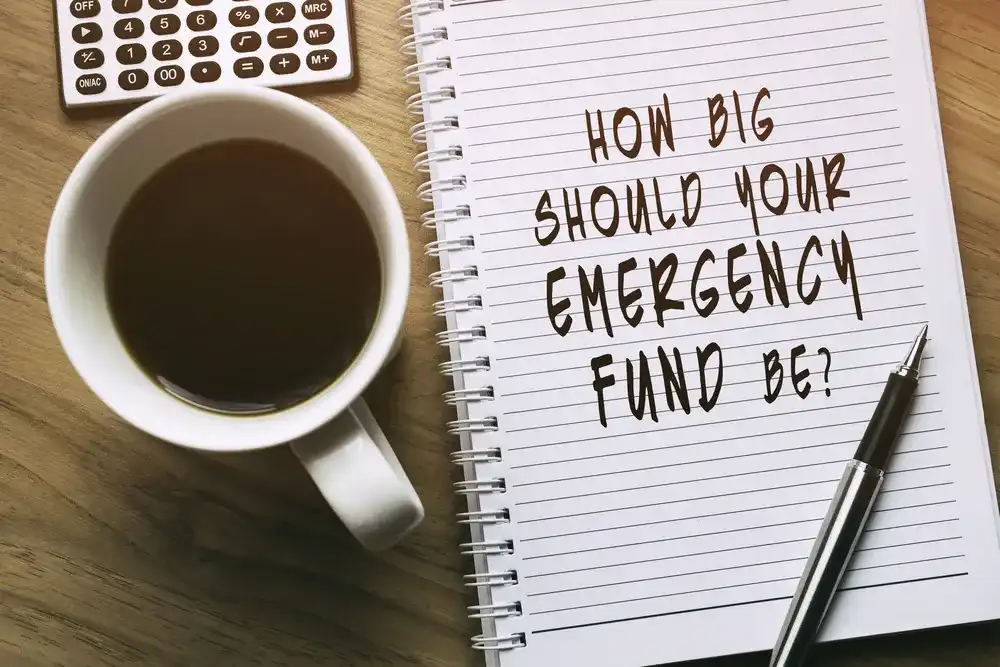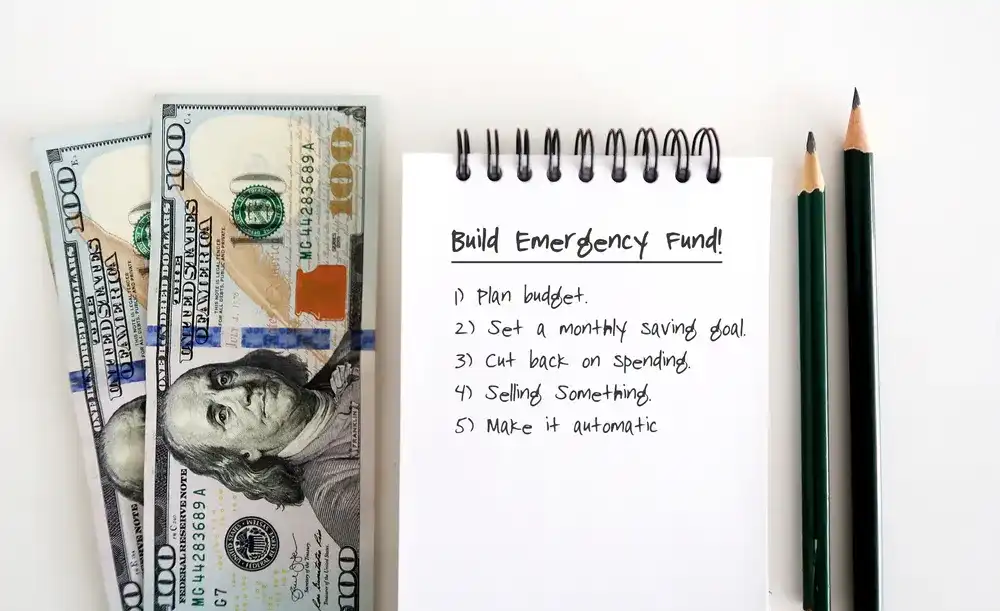Emergency Fund Essentials: How Much Money Do I Need?
An emergency fund isn't just a financial cushion; it's your safety net in the face of unexpected curveballs. Picture it as your financial superhero, ready to rescue you from the unpredictability of life. Whether it's sudden car repairs, a leaky roof, hefty medical bills, or an unexpected income hiccup, your emergency fund has your back.
Surprisingly, a 2023 survey revealed that only 30% of adults have some emergency savings. Yet, here's the kicker: this percentage is actually up from 27% in 2022. Even more concerning, one in four (22 percent) U.S. adults admit to having zero emergency savings.
How Much Should I Have in an Emergency Fund?
Consider your emergency fund as more than mere spare change—it's a calculated defense against life's unforeseen challenges. Beyond a simple cash reserve, it shields you from unexpected events like we listed earlier.
Being ready for the unpredictable is crucial. According to Bankrate's Annual Emergency Fund Report, a substantial 68% of individuals harbor concerns about covering living expenses for a solitary month in the event of primary income loss. Further, 57% of U.S. adults presently lack the financial capacity to navigate a $1,000 emergency expense without strain.
This article will guide you in leveraging your family budget to fortify not only your emergency fund but also lay the foundation for a secure retirement ahead. Let's navigate the financial landscape, ensuring your money serves you well, despite life's unexpected turns.

What is an Emergency Fund?
If you've made it this far, chances are you're well acquainted with the concept of an emergency fund by now. However, the real revelation lies in recognizing the number of unforeseen events that necessitate you needing one in the first place. The fact is that life is a master of surprises, and your emergency fund serves as a financial shield against its curveballs.
Consider these top six unexpected expenses that could catch you off guard:
- Job Loss and Unemployment: Sudden unemployment can swiftly turn financial stability into uncertainty.
- Funerals: The cost of saying goodbye can be unexpectedly high, adding emotional strain to financial pressure.
- Pet Emergencies and Vet Bills: Furry family members may require urgent medical attention, impacting your budget.
- School Tuition and Fees: Unexpected educational expenses can disrupt your financial plans.
- College Tuition and Fees: Higher education costs may fluctuate, catching you unprepared.
- Tax Increases: Unanticipated tax hikes can strain your finances, necessitating a ready fund.
General Guidelines for Your Emergency Fund
So, the burning question is: how much should you stash away in your emergency fund? There's no one-size-fits-all answer, and various schools of thought exist. At Cash Store, we advocate for setting aside at least three to six months' living expenses. It sounds like a lot, right? We get it, so let's break it down.
For someone earning $30,000 annually, a three-month emergency fund would be $7,500. Six months would be $15,000. If you're in the $60,000 bracket, it translates to $15,000 for three months and $30,000 for six months. For those earning $100,000, it means $25,000 for three months and $50,000 for six months.
Now, let's address the elephant in the room: saving this much can be challenging, especially when living paycheck to paycheck. The key is to work backward. Enter the 50/20/30 budgeting philosophy. Allocate 50% to necessities, 30% to discretionary spending, and the crucial 20%? That's your game-changer—encompassing both the emergency fund and retirement savings.
If you’re spending too much in the needs category (your necessities), it may mean you are living beyond your means and you need to make some tough decisions. Further, if you are spending too much on your wants (discretionary spending), it’s time to pull back the reigns and think through how much you actually can, and should, be spending on those items.
By incorporating this philosophy into your financial plan, you're not just preparing for the unexpected; you're laying the groundwork for a secure future. It's about finding balance and making every dollar work for you.
Calculating Your Ideal Emergency Fund
Curious about calculating your ideal emergency fund? We've got your back. Let's employ the 50/20/30 philosophy to craft a scenario and walk you through the steps.
Imagine a net monthly income of $4,000. Following the 50/20/30 rule, allocate $2,000 (50%) to necessities, $1,200 (30%) to discretionary spending, and the magical $800 (20%) to your emergency fund and retirement savings combined.
- Identify Necessities: List essential expenses like rent, utilities, and groceries, totaling $2,000.
- Allocate Discretionary Spending: Deduct $1,200 for non-essential but enjoyable expenses such as buying a new pair of jeans, going out to dinner with your friends, or getting in an extra game of golf.
- Emergency Fund and Retirement: Now, you're left with $800 for your financial safety net and retirement savings.
To streamline this process, consider utilizing emergency fund calculators. PNC Bank, Fifth Third Bank, and Money Under 30 offer reliable tools. These calculators analyze your income, expenses, and financial goals to determine the optimal emergency fund amount.

Strategies for Building Your Emergency Fund
Building a robust emergency fund demands practical saving tips and savvy budgeting strategies. Let's explore a set of original approaches tailored to your financial journey.
- Leverage Interest-Bearing Accounts: Opt for a basic savings or money market account, but seek out options that safeguard your funds and offer a return on your investment.
- Prioritize High-Yield Returns: Look for accounts that actively contribute to your savings. Seek financial institutions that reward your commitment with competitive interest rates, helping your emergency fund grow organically.
- Incremental Contributions: Start small and gradually increase your contributions. Consistency is key; even modest monthly additions can accumulate over time, significantly boosting your financial safety net.
- Preserve for True Emergencies: Use your emergency fund judiciously—strictly for genuine emergencies. This ensures the fund is available when you truly need it, safeguarding your financial stability.
- Replenish with Diligence: If you do tap into your emergency fund, make it a priority to replenish the withdrawn amount. This proactive approach maintains the fund's integrity, ensuring it's ready for future unexpected expenses.
Where to Keep Your Emergency Fund
Experts advise placing your emergency fund in an account that offers liquidity, easy accessibility, and is entirely separate from your primary financial accounts, such as your everyday checking account. The goal is to keep it out of sight and out of mind until the unforeseen strikes.
Consider high-yield savings and money market accounts as prime locations to safeguard your funds. These options provide a secure environment for your emergency fund and offer the potential for modest growth, ensuring your money works for you even while in reserve.
While stashing some cash at home is acceptable, relying on your residence for a significant portion of your emergency fund is not recommended. Beyond the risk of loss or theft, storing a substantial sum in your house leaves it susceptible to damage, misplacement, or theft. Unlike other forms of payment, cash is irreplaceable; once gone, it's gone.
Maintaining and Managing Your Emergency Fund
Contributing to your emergency savings isn't a static process; life changes can alter your financial landscape. A promotion, pay increase, or significant life event may affect your ability to contribute. As your circumstances change, be sure to review and adjust your emergency fund accordingly.
Regularly reassessing your fund, ideally annually, is necessary to keep you on track. If a financial advisor isn't in the cards, use tax time as an opportune moment for this evaluation. Consider these practical steps for maintaining and managing your emergency fund:
- Regular Reviews: Periodically evaluate your fund's adequacy based on changes in income, expenses, and life circumstances.
- Financial Advisor Consultation: If possible, consult a financial advisor at least once a year to ensure your emergency fund aligns with your broader financial goals.
Now, let's navigate around common pitfalls:
- Underestimating Expenses: Failing to consider all potential emergency expenses can leave you with an inadequate fund. Be thorough in anticipating potential financial setbacks.
- Overlooking Fund Adjustments: Life changes, and so should your emergency fund. Ignoring adjustments based on income fluctuations or increased living costs can compromise your financial resilience.
- Tapping for Non-Emergencies: Resist the urge to dip into your fund for non-urgent expenses. Maintaining discipline ensures your safety net remains intact for genuine emergencies.
- Ignoring Inflation: Over time, inflation erodes the purchasing power of your emergency fund. Periodic adjustments help counteract this impact.
Empower Your Financial Future: Taking Action on Your Emergency Fund
Remember, your emergency fund is more than a financial cushion—it's your shield against life's unexpected twists. Periodically review and adjust your fund as circumstances change, seeking guidance from a financial advisor if possible. Avoid common pitfalls, and be diligent in contributing, especially during periods of increased financial capacity.
By embracing these principles, you're not just preparing for the unforeseen; you're securing your financial well-being.

FAQs
What is an emergency fund, and why is it important?
An emergency fund is a financial safety net, a stash of readily accessible cash reserved for unforeseen expenses like medical bills, car repairs, or job loss. It provides financial security, preventing debt accumulation during emergencies and offering peace of mind, ensuring you can weather life's unexpected storms without compromising your financial stability.
How much money should be in an emergency fund?
The ideal amount for an emergency fund varies based on individual financial circumstances. However, we recommend setting aside three to six months of living expenses, exclusive of retirement savings contributions. This ensures a personalized safety net, providing financial security during unexpected setbacks without compromising long-term retirement goals. Adjust the target based on your unique financial situation for optimal preparedness.
How do I calculate how much I need in my emergency fund?
Calculate your ideal emergency fund by employing the 50/20/30 principle. Allocate 50% to necessities, 30% to discretionary spending, and reserve 20% for emergencies and retirement savings. Use handy calculators from reliable sources like PNC Bank, Fifth Third Bank, and Money Under 30 for a more precise figure. These tools analyze your unique financial landscape, ensuring your emergency fund aligns seamlessly with your budget and goals.
Where should I keep my emergency fund?
Safeguard your emergency fund by keeping it in accounts that offer liquidity, easy accessibility, and separation from primary financial accounts. High-yield savings accounts and money market accounts are secure options, ensuring your fund is safe and continues to grow. Storing substantial amounts at home presents risks of loss or theft, emphasizing the importance of reputable financial institutions for a secure and easily accessible emergency fund.
How can I build an emergency fund on a low income?
Building an emergency fund on a low income means you need to take some thoughtful yet diligent steps. Instead of trying to tackle one intimidating goal that could dissuade you altogether, set achievable smaller milestones. Initiate your journey with modest, regular contributions, and automate savings to ensure consistency. Resist the urge to increase spending or open new credit cards. Balance is key—avoid over-saving and focus on gradual, sustainable progress, setting the stage for a resilient financial safety net.
Should my emergency fund cover 3 or 6 months of expenses?
Experts universally recommend aiming for an emergency fund covering three to six months of expenses. The decision hinges on your specific circumstances, considering factors like job stability and financial commitments. While three months provides a baseline, opting for a six-month cushion offers enhanced security. Tailor your decision to your unique situation, balancing enough coverage and practicality based on your financial landscape.

Can an emergency fund be too big?
Yes, an emergency fund can be excessively large. Parking substantial sums in low-interest accounts risks losing value to inflation. This approach might neglect tax advantages; over-contributing to an emergency fund could divert funds from tax-advantaged retirement options like a 401(k) or IRA. The key is to strike a balance, ensuring your emergency fund is robust while optimizing opportunities for growth and tax savings in retirement accounts.
How often should I review and adjust my emergency fund?
Regularly review and adjust your emergency fund at least once a year for optimal financial resilience. Consider partnering with a financial advisor during this assessment to ensure alignment with broader financial goals. This proactive approach ensures that your emergency fund remains well-suited to evolving circumstances and stands as a reliable financial safety net.
Are there any tools or apps to help manage my emergency fund?
Absolutely! You can streamline your emergency fund management with budgeting apps like Mint, Oportun, Acorns, and YNAB. These tools offer intuitive interfaces, automate savings, and provide insights into spending patterns. You can effortlessly track and grow your emergency fund, leveraging technology to enhance financial management and build a robust financial safety net.
What types of expenses should my emergency fund cover?
Your emergency fund should cover unforeseen expenses like medical bills, car repairs, job loss, or tax increases. It acts as a financial safety net, helping to protect you from unexpected setbacks. These funds are designed for genuine emergencies, ensuring you're well-prepared to navigate life's unpredictable twists without compromising your financial stability or accumulating debt.
The content on this page provides general consumer information or tips. It is not financial advice or guidance. Each person’s circumstances are unique. The Cash Store may update this information periodically. This information may also include links or references to third-party resources or content. We do not endorse the third-party or guarantee the accuracy of this third-party information. There may be other resources that also serve your needs.
More Articles
What to Know About Crypto-Backed Loans
Curious about using your crypto as collateral? Discover how crypto-backed loans work, their benefits, risks, and what to consider before borrowing.
Read More >How Does Installment Loan Approval Work?
Curious about how installment loan approval works? Learn about the key factors lenders consider, the application process, and tips to improve your chances of approval.
Read More >Is it Better to Get an Installment Loan or Line of Credit?
Installment loan or line of credit—which is right for you? Learn the key differences, pros and cons, and how to choose the best option for your financial needs.
Read More >Loan Amount is subject to loan approval. Loan terms and availability may vary by location. Approval rate based on complete applications received across all Cash Store locations. Customers can typically expect to receive loan proceeds in less than 20 minutes; however, processing times may vary. Loans / Advances are provided based on approved credit. Each applicant for credit is evaluated for creditworthiness.
Please see the Licenses and Rates page for additional product details.
Cash Store offers consumer credit products that are generally short-term in nature and not intended for long-term borrowing needs.
In Texas, Cash Store is a Credit Services Organization. Loans are provided by a non-affiliated third-party lender. Please see the Licenses and Rates page for links to Consumer Disclosures and choose the one for the product and amount that most closely relates to your loan request.
Customer Portal residency restrictions apply. Availability of funds may vary by financial institution.

